Acer Aspire 7560G: an impressive desktop with a new-generation AMD quad-core processor
In this post we will talk about a laptop on the new mobile platform AMD, on which I have been working for six months already. But first, it makes sense to say a few words about his equally large-sized predecessor, who faithfully served me for two and a half years, and about the upgrades he underwent during this time.

More than two years ago, I realized that I needed a home laptop - with a comfortable keyboard, a large screen and fairly high performance. Such that once again does not include a powerful, but quite voracious and noisy home computer. I also liked the opportunity to “put to sleep” the laptop in a matter of seconds and just as quickly “wake up”, getting on the screen a full set of open windows, applications and an unfinished article.
')
I will not hide, at first the desire and most seemed a whim. But now I'm so used to a bunch of “big laptop - PCs” that I can't even imagine how I lived without it before. Indeed, it is very convenient to have both at hand, although, of course, it is not very economically justified, even taking into account three times less power consumption of a laptop. And in the summer of 2009, I took a hefty Packard Bell EasyNote LJ65. The machine at that time was quite serious: Core 2 Duo T6500 2.1 GHz, 3 GB DDR3, 250 GB hard disk, GeForce 130M video card. And, of course, the screen with a diagonal of 17.3 inches and a resolution of 1600x900 produced a strong impression. The matrix is TN there, but for the eyes it's pretty pleasant, especially if you twist half the brightness - which I immediately did. And in November - a free upgrade program - replaced Vista Home Premium with a similar Windows 7, only now the 64-bit version. Since then, the operating system has not been reinstalled, and when replacing hard drives, which I will discuss in more detail below, I just flooded the image from its predecessor.

Portrait of Packard Bell LJ65, made this morning
For two and a half years, LJ65 has been repeatedly upgraded. Almost immediately, I changed the WiFi adapter in it from Intel (I don’t remember which one) 802.11G to Atheros AR5B91 from 802.11n. Then there was a shortage of 250 gigs on the hard drive, and I put another one in the neighborhood - a 750-gigabyte WD. It turned out to be very easy to do: in all large Packard Bell and Acer (which is essentially the same thing) there are two slots for disks. About a year and a half ago, I came across an Intel 80GB SSD - the very first one. Out of curiosity, I cloned the system onto it, and it stayed on - the computer became very ... responsive. Unfortunately, over time, 80 gigabytes began to be missed, and literally 2-3 gigabytes of free space remained on the disk. It seems that the swap file was cut off indecently, and I clean up the temporary files mercilessly, but - like that. The latest upgrade is an increase in memory up to 8 gigabytes. I wouldn’t say that such a volume was really necessary for me, but I turned up a couple of modules that were in use for a ridiculous price — and could not resist.
As a result, we have the following performance picture:
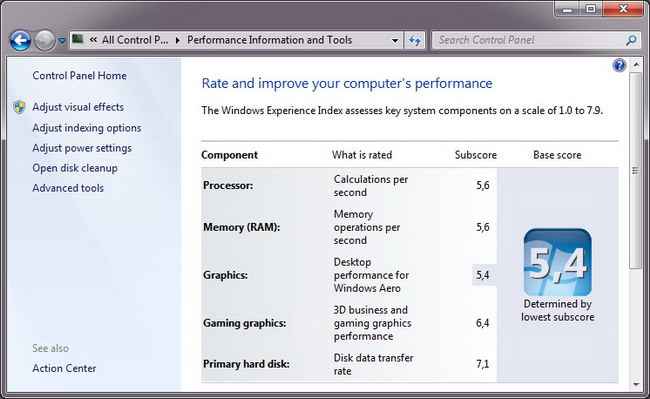
Yes, to the issue of product quality. The only failure that occurred during the considerable period of the time is a partial failure of one USB port. But this is completely my fault: after chasing compactness, I used a microSD card for the Turbo Boost through a nameless Chinese adapter. The card worked fine, but the adapter one day just crumbled into pieces, and something remained inside the port. Cleaned, cleaned, but still the port now works through time, which, however, strains slightly, considering the presence of three more. And so - no problems, and even the propellers make no more noise than on the first day of their acquaintance.
So, we probably would have lived together for a year or two, but then we needed our grown-up daughter's computer.
It is clear that the best is for children, but, given the more than modest needs of my daughter and unwillingness to pamper the child, I decided to give her Packard Bell, and take a more recent copy to myself. At the same time, the list of requirements remained the same: a large screen, two jacks for hard drives, 802.11n, and the rest is how it goes.
For many years of habit, I always start to choose a laptop with a study of the Acer model range. The point here is not about religious preferences (um, though — how to know), but a combination of two factors: a normal price and a comfortable keyboard. My work is mainly related to writing, and the last factor is very, very important. Meanwhile, my fingers are categorically incompatible with Asus and Samsung keyboards, even if you crack. With Sony fingers are friends, but there the price tag is not very humane. I’m good to Lenovo and bought their ThinkPad X201s for trips last winter (I wrote something about it in a blog about it), but it’s in the segment of large notebooks that they are somehow boring now, and the price tags are higher than those of Acer.
At first, I stopped at the Acer Aspire 7750G - a core i3 test core in conjunction with a Radeon 6650 video card. I almost decided to take it, but then I caught a glimpse of the Aspire 7560G on the quad-core AMD A6. And here curiosity awoke in me ... The fact is that my very first computer (286th) was also on AMD, and then I went to AMD K5-PR133 with all the stops, including the mysterious 5x86-P75 processor . And then - as it was cut off, and since 1998, I changed Intel only once, when I bought a laptop on VIA C3. And now - AMD A6-3400M. Four cores, but not simple, but with an integrated graphics chip Radeon 6520, which can work in conjunction with the main 6650 (all together is called the Radeon HD6720G2). And the rest of the same 7750 - screen 17.3, 4 gigabytes of memory, hard on 500 hectares, a scrap of Windows Home Basic. And all this is a thousand cheaper (22,740 rubles versus 23,650). Of course, I wasn’t very excited about the four cores of AMD, because I’ve heard that now they are going to Intel’s about 2 to 1, but still it’s wildly curious.
In general, I decided to take the option on AMD, having decided that for my tasks, there would be enough performance in any case, and if for less money I find myself in the black, then fine. But if you don’t like it, there will be something to do on Habré :).
Here are some screenshots of CPU-Z with details about the processor and the stuffing.
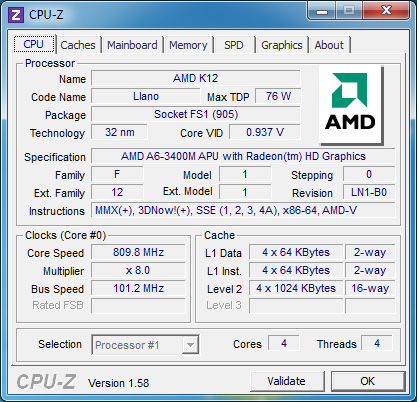
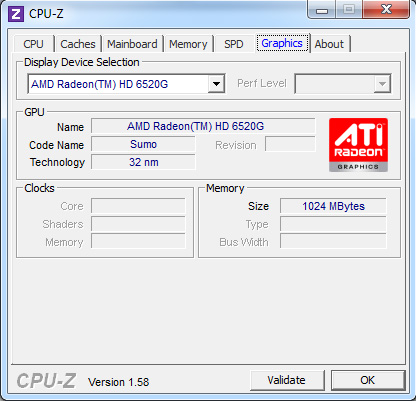
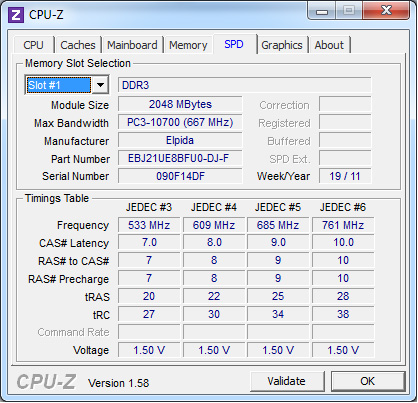
The box of this beast is, of course, impressive - almost 60 centimeters in length and 30 in height. In this case, the laptop itself is only 44 centimeters in length, and the remaining 15 are used to house the power supply unit with a battery. Besides them and a few pieces of paper there is nothing inside.
I’m not going to talk about design: the laptop looks decent, and more is not required of it. I was pleased that the cover is now not glossy, but slightly ribbed and, as they say, “rubberized” (see photo at the beginning of the post). True, I have a feeling that dust will gather in the hollows, but it is usually less noticeable than fingers on gloss.
The keyboard is a little less than luxurious. Fingers fall immediately as it should, able to type blindly (this is me about myself) fall from the first time. True, Acer continues to make the Insert and Delete buttons very, very small, but you can use their duplicates on the numeric keypad or just get used to it. I got used to it for two and a half years. The touchpad, too, probably could have been made bigger, since there is enough free space on the case. But, on the other hand, next to the desktop, in fact, the computer will always find a place for the mouse.
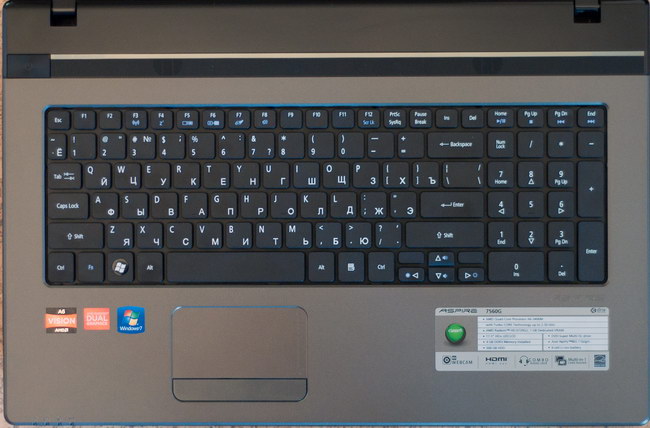
A good half of the back cover can be easily removed, exposing memory chips, a WiFi adapter and two hard disk slots. And here we are waiting for a kind of surprise from Acer: not every disk will enter the unoccupied slot. Or rather, only very thin ones, like the Seagate Momentus Thin or the “refined” SSD. Normal HDD will not enter even if you saw plastic protrusions on the inside of the cover (I tried, it did not help). Honestly, I don’t really understand - why this is done, but how it is. If I had known about such cunning before, I would immediately buy another SSD model, thinner. And now you have to take Momentus Thin for more or less large files. It costs a little more than regular disks, but still it is an extra waste ...
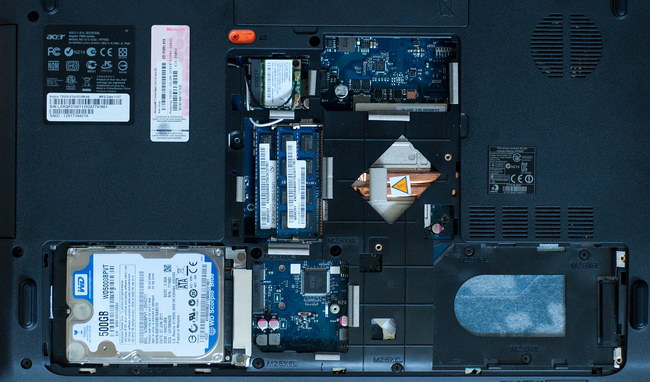
But let's temporarily forget about all sorts of upgrades and go back to the laptop itself. It works very quietly. Right very much. Without a load, it is not audible at all (the processor works most of the time at a frequency of 809 MHz), under which it barely rustles. At the same time, there is no effect of the burned knees, like in notebooks on AMD, posture before last generation. The screen, as far as I can tell, is the same as in the old laptop - no better and no worse. The reserve of brightness is gigantic again. To save eyes, I recommend twisting it to a maximum of 55-60 percent. There are only three USB ports (there are four in the LJ65) and all support only USB 2.0. This is a bit disappointing, especially since the Acer Aspire 7750G on Core i3 still had 3.0 support ... It’s quite possible to live without it, since almost all the data on my network drive, to which the laptop connects via WiFi (by the way, the integrated adapter stably connects at a speed of 300 Mbit / s instead of 150, as old), and fast external disks would be useful except for backup once a week. And yet - unpleasant.
And now, perhaps, the main thing - about performance. That's what the operating system itself thinks about it.
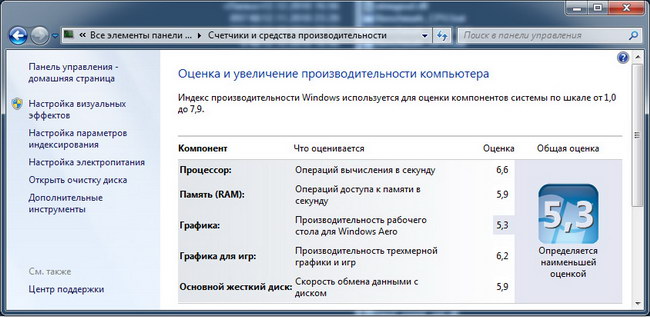
As we can see, its opinion is rather restrained - according to most of the parameters, the new system is ahead of the old one very slightly (we don’t look at the hard disk figures yet - it’s hard to outrun an old but decent SSD HDD).
But maybe in real applications the increase will be greater? For example, I used to trust the opinion of WinRAR, because a) archived something really often has to, and b) it competently works with multi-core processors. At 2.1-gigahertz Core 2 Duo, the built-in benchmark showed 761 units, and on AMD A6 it knocked out 1015. It is, of course, clear that the frequency of the AMD processor is only 1.4 GHz, but there are four cores! In general, there is a gain, but ambiguous. Especially if you remember that the previous-generation dual-core Core i3, operating at 2.4 GHz, squeezes 1567 points. You can reasonably reassure yourself that such processor performance is more than enough for the vast majority of tasks, including video conversion for various mobile devices (I myself do this regularly). Nevertheless, it is worth noting that in this case, the four cores are not a sign of unprecedented power, but only an opportunity to compete with inexpensive Intel dual-core ...
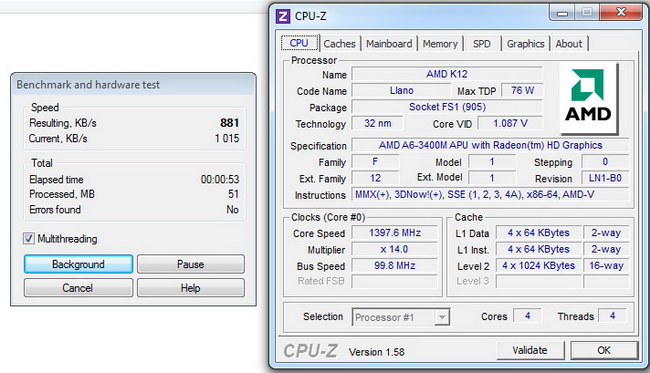
Please note that the score is much lower than the result achieved a little later. It seems that the processor accelerates to maximum speed somehow slowly
But maybe the system will do everything in games, because it already has two graphics cards in the asset! Both, however, do not miss the stars from the sky, but, united in CrossFire, they can show quite a decent result. This is what GPU-Z says about them:

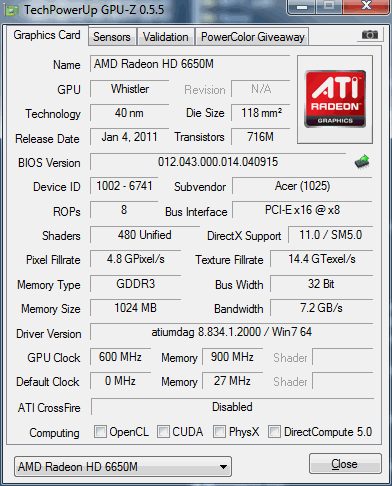
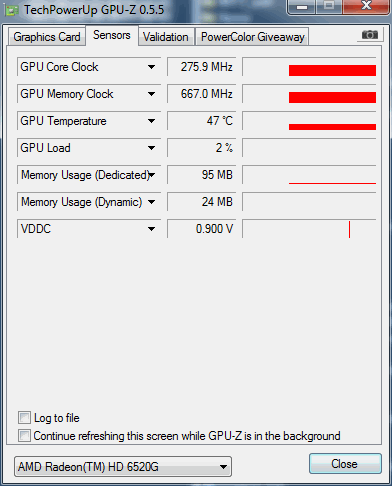
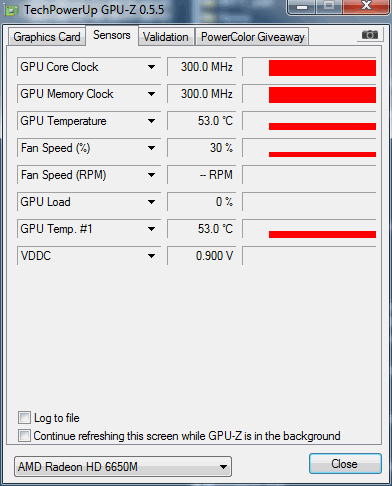
It is a little surprising how much the bus is clamped on the main video chip 6650. What is the use of a larger number of universal processors and a decent frequency if all this is stuffed into 32 bits? Mysterious decision. But the built-in main processor 6520 is surprisingly good.
According to my observations, if the system normally pulls the first Crysis, there is no particular problem with everything else. So I inform you: with all the settings set to High and at a resolution of 1600x900 (of course, in DirectX 10 mode), the pair squeezes out an average of 25-30 frames per second. At levels with snow, traditionally the most difficult for a video card, it turns out 16-17. This means quite decent "playability" even for such a voracious product like Crysis. All there Alice: Madness Returns, Bulletstorm, Modern Warfare 2 and others are worn, as announced - it makes no sense to measure FPS. Metro 2033, however, slows down a lot, but on the desktop Radeon 6850, to put it mildly, it does not fly.
What can be summed up?
If you do not expect miracles from the Aspire 7560G (four cores! Two video cards !!!), it is very good as a replacement for a desktop computer. It is convenient to work on it, the screen is suitable for watching movies in a small company, and the sound is quite appropriate for movies and games (Dolby Advanced Audio is written on the casing, but I'm already a little confused at the zoo "Dolby" and I don’t know how cool).
The default WD Scorpio Blue with a spindle speed of 5400 rpm is fast enough, but I, accustomed to the charms of SSD, will soon make a total disk subsystem upgrade. Honestly, I was originally going to just add an SSD, and turn the Scorpio into a file storage, but because of the very strange approach to the design of the second HDD slot, we have to take a thin, seven-millimeter Momentus Thin to store all different things, it costs about 1,500 rubles for 320 gigabytes. And I already have an SSD, it's a 120-gigabyte OCZ Agility 3, made on the second-generation SandForce chip.

For its price (6000 rubles) the option is very sensible, and in SATA 3 mode it gives up to 350 megabytes when reading and up to 320 when writing. In a laptop, he will be able to turn around to the fullest, the benefits of SATA 3 Aspire 7560 support. True, at first there were some rough spots with firmware, because of which the SSD suddenly mysteriously disappeared from the system, but now it has been fixed.

Aspire 7560G performance with SSD OCZ installed. A little bit did not reach the maximum score
And, of course, dragging 8 gigabytes of memory into it will be useful.
I am glad that AMD has got a really decent and relatively inexpensive mobile platform. If only she could compete for the price not with Intel Core, but with Pentium and Celeron - then it would be quite interesting. Perhaps in another couple of years, when I think again about the upgrade of the Big Laptop, the competition will be even tougher. After all, the real benefits of the APU (CPU and GPU in one bottle) that AMD is so proud of (the A6 / A8 processors among them) should start to be felt from 2013 onwards ...

More than two years ago, I realized that I needed a home laptop - with a comfortable keyboard, a large screen and fairly high performance. Such that once again does not include a powerful, but quite voracious and noisy home computer. I also liked the opportunity to “put to sleep” the laptop in a matter of seconds and just as quickly “wake up”, getting on the screen a full set of open windows, applications and an unfinished article.
')
I will not hide, at first the desire and most seemed a whim. But now I'm so used to a bunch of “big laptop - PCs” that I can't even imagine how I lived without it before. Indeed, it is very convenient to have both at hand, although, of course, it is not very economically justified, even taking into account three times less power consumption of a laptop. And in the summer of 2009, I took a hefty Packard Bell EasyNote LJ65. The machine at that time was quite serious: Core 2 Duo T6500 2.1 GHz, 3 GB DDR3, 250 GB hard disk, GeForce 130M video card. And, of course, the screen with a diagonal of 17.3 inches and a resolution of 1600x900 produced a strong impression. The matrix is TN there, but for the eyes it's pretty pleasant, especially if you twist half the brightness - which I immediately did. And in November - a free upgrade program - replaced Vista Home Premium with a similar Windows 7, only now the 64-bit version. Since then, the operating system has not been reinstalled, and when replacing hard drives, which I will discuss in more detail below, I just flooded the image from its predecessor.

Portrait of Packard Bell LJ65, made this morning
For two and a half years, LJ65 has been repeatedly upgraded. Almost immediately, I changed the WiFi adapter in it from Intel (I don’t remember which one) 802.11G to Atheros AR5B91 from 802.11n. Then there was a shortage of 250 gigs on the hard drive, and I put another one in the neighborhood - a 750-gigabyte WD. It turned out to be very easy to do: in all large Packard Bell and Acer (which is essentially the same thing) there are two slots for disks. About a year and a half ago, I came across an Intel 80GB SSD - the very first one. Out of curiosity, I cloned the system onto it, and it stayed on - the computer became very ... responsive. Unfortunately, over time, 80 gigabytes began to be missed, and literally 2-3 gigabytes of free space remained on the disk. It seems that the swap file was cut off indecently, and I clean up the temporary files mercilessly, but - like that. The latest upgrade is an increase in memory up to 8 gigabytes. I wouldn’t say that such a volume was really necessary for me, but I turned up a couple of modules that were in use for a ridiculous price — and could not resist.
As a result, we have the following performance picture:

Yes, to the issue of product quality. The only failure that occurred during the considerable period of the time is a partial failure of one USB port. But this is completely my fault: after chasing compactness, I used a microSD card for the Turbo Boost through a nameless Chinese adapter. The card worked fine, but the adapter one day just crumbled into pieces, and something remained inside the port. Cleaned, cleaned, but still the port now works through time, which, however, strains slightly, considering the presence of three more. And so - no problems, and even the propellers make no more noise than on the first day of their acquaintance.
So, we probably would have lived together for a year or two, but then we needed our grown-up daughter's computer.
It is clear that the best is for children, but, given the more than modest needs of my daughter and unwillingness to pamper the child, I decided to give her Packard Bell, and take a more recent copy to myself. At the same time, the list of requirements remained the same: a large screen, two jacks for hard drives, 802.11n, and the rest is how it goes.
For many years of habit, I always start to choose a laptop with a study of the Acer model range. The point here is not about religious preferences (um, though — how to know), but a combination of two factors: a normal price and a comfortable keyboard. My work is mainly related to writing, and the last factor is very, very important. Meanwhile, my fingers are categorically incompatible with Asus and Samsung keyboards, even if you crack. With Sony fingers are friends, but there the price tag is not very humane. I’m good to Lenovo and bought their ThinkPad X201s for trips last winter (I wrote something about it in a blog about it), but it’s in the segment of large notebooks that they are somehow boring now, and the price tags are higher than those of Acer.
At first, I stopped at the Acer Aspire 7750G - a core i3 test core in conjunction with a Radeon 6650 video card. I almost decided to take it, but then I caught a glimpse of the Aspire 7560G on the quad-core AMD A6. And here curiosity awoke in me ... The fact is that my very first computer (286th) was also on AMD, and then I went to AMD K5-PR133 with all the stops, including the mysterious 5x86-P75 processor . And then - as it was cut off, and since 1998, I changed Intel only once, when I bought a laptop on VIA C3. And now - AMD A6-3400M. Four cores, but not simple, but with an integrated graphics chip Radeon 6520, which can work in conjunction with the main 6650 (all together is called the Radeon HD6720G2). And the rest of the same 7750 - screen 17.3, 4 gigabytes of memory, hard on 500 hectares, a scrap of Windows Home Basic. And all this is a thousand cheaper (22,740 rubles versus 23,650). Of course, I wasn’t very excited about the four cores of AMD, because I’ve heard that now they are going to Intel’s about 2 to 1, but still it’s wildly curious.
In general, I decided to take the option on AMD, having decided that for my tasks, there would be enough performance in any case, and if for less money I find myself in the black, then fine. But if you don’t like it, there will be something to do on Habré :).
Here are some screenshots of CPU-Z with details about the processor and the stuffing.



The box of this beast is, of course, impressive - almost 60 centimeters in length and 30 in height. In this case, the laptop itself is only 44 centimeters in length, and the remaining 15 are used to house the power supply unit with a battery. Besides them and a few pieces of paper there is nothing inside.
I’m not going to talk about design: the laptop looks decent, and more is not required of it. I was pleased that the cover is now not glossy, but slightly ribbed and, as they say, “rubberized” (see photo at the beginning of the post). True, I have a feeling that dust will gather in the hollows, but it is usually less noticeable than fingers on gloss.
The keyboard is a little less than luxurious. Fingers fall immediately as it should, able to type blindly (this is me about myself) fall from the first time. True, Acer continues to make the Insert and Delete buttons very, very small, but you can use their duplicates on the numeric keypad or just get used to it. I got used to it for two and a half years. The touchpad, too, probably could have been made bigger, since there is enough free space on the case. But, on the other hand, next to the desktop, in fact, the computer will always find a place for the mouse.

A good half of the back cover can be easily removed, exposing memory chips, a WiFi adapter and two hard disk slots. And here we are waiting for a kind of surprise from Acer: not every disk will enter the unoccupied slot. Or rather, only very thin ones, like the Seagate Momentus Thin or the “refined” SSD. Normal HDD will not enter even if you saw plastic protrusions on the inside of the cover (I tried, it did not help). Honestly, I don’t really understand - why this is done, but how it is. If I had known about such cunning before, I would immediately buy another SSD model, thinner. And now you have to take Momentus Thin for more or less large files. It costs a little more than regular disks, but still it is an extra waste ...

But let's temporarily forget about all sorts of upgrades and go back to the laptop itself. It works very quietly. Right very much. Without a load, it is not audible at all (the processor works most of the time at a frequency of 809 MHz), under which it barely rustles. At the same time, there is no effect of the burned knees, like in notebooks on AMD, posture before last generation. The screen, as far as I can tell, is the same as in the old laptop - no better and no worse. The reserve of brightness is gigantic again. To save eyes, I recommend twisting it to a maximum of 55-60 percent. There are only three USB ports (there are four in the LJ65) and all support only USB 2.0. This is a bit disappointing, especially since the Acer Aspire 7750G on Core i3 still had 3.0 support ... It’s quite possible to live without it, since almost all the data on my network drive, to which the laptop connects via WiFi (by the way, the integrated adapter stably connects at a speed of 300 Mbit / s instead of 150, as old), and fast external disks would be useful except for backup once a week. And yet - unpleasant.
And now, perhaps, the main thing - about performance. That's what the operating system itself thinks about it.

As we can see, its opinion is rather restrained - according to most of the parameters, the new system is ahead of the old one very slightly (we don’t look at the hard disk figures yet - it’s hard to outrun an old but decent SSD HDD).
But maybe in real applications the increase will be greater? For example, I used to trust the opinion of WinRAR, because a) archived something really often has to, and b) it competently works with multi-core processors. At 2.1-gigahertz Core 2 Duo, the built-in benchmark showed 761 units, and on AMD A6 it knocked out 1015. It is, of course, clear that the frequency of the AMD processor is only 1.4 GHz, but there are four cores! In general, there is a gain, but ambiguous. Especially if you remember that the previous-generation dual-core Core i3, operating at 2.4 GHz, squeezes 1567 points. You can reasonably reassure yourself that such processor performance is more than enough for the vast majority of tasks, including video conversion for various mobile devices (I myself do this regularly). Nevertheless, it is worth noting that in this case, the four cores are not a sign of unprecedented power, but only an opportunity to compete with inexpensive Intel dual-core ...

Please note that the score is much lower than the result achieved a little later. It seems that the processor accelerates to maximum speed somehow slowly
But maybe the system will do everything in games, because it already has two graphics cards in the asset! Both, however, do not miss the stars from the sky, but, united in CrossFire, they can show quite a decent result. This is what GPU-Z says about them:




It is a little surprising how much the bus is clamped on the main video chip 6650. What is the use of a larger number of universal processors and a decent frequency if all this is stuffed into 32 bits? Mysterious decision. But the built-in main processor 6520 is surprisingly good.
According to my observations, if the system normally pulls the first Crysis, there is no particular problem with everything else. So I inform you: with all the settings set to High and at a resolution of 1600x900 (of course, in DirectX 10 mode), the pair squeezes out an average of 25-30 frames per second. At levels with snow, traditionally the most difficult for a video card, it turns out 16-17. This means quite decent "playability" even for such a voracious product like Crysis. All there Alice: Madness Returns, Bulletstorm, Modern Warfare 2 and others are worn, as announced - it makes no sense to measure FPS. Metro 2033, however, slows down a lot, but on the desktop Radeon 6850, to put it mildly, it does not fly.
What can be summed up?
If you do not expect miracles from the Aspire 7560G (four cores! Two video cards !!!), it is very good as a replacement for a desktop computer. It is convenient to work on it, the screen is suitable for watching movies in a small company, and the sound is quite appropriate for movies and games (Dolby Advanced Audio is written on the casing, but I'm already a little confused at the zoo "Dolby" and I don’t know how cool).
The default WD Scorpio Blue with a spindle speed of 5400 rpm is fast enough, but I, accustomed to the charms of SSD, will soon make a total disk subsystem upgrade. Honestly, I was originally going to just add an SSD, and turn the Scorpio into a file storage, but because of the very strange approach to the design of the second HDD slot, we have to take a thin, seven-millimeter Momentus Thin to store all different things, it costs about 1,500 rubles for 320 gigabytes. And I already have an SSD, it's a 120-gigabyte OCZ Agility 3, made on the second-generation SandForce chip.

For its price (6000 rubles) the option is very sensible, and in SATA 3 mode it gives up to 350 megabytes when reading and up to 320 when writing. In a laptop, he will be able to turn around to the fullest, the benefits of SATA 3 Aspire 7560 support. True, at first there were some rough spots with firmware, because of which the SSD suddenly mysteriously disappeared from the system, but now it has been fixed.

Aspire 7560G performance with SSD OCZ installed. A little bit did not reach the maximum score
And, of course, dragging 8 gigabytes of memory into it will be useful.
I am glad that AMD has got a really decent and relatively inexpensive mobile platform. If only she could compete for the price not with Intel Core, but with Pentium and Celeron - then it would be quite interesting. Perhaps in another couple of years, when I think again about the upgrade of the Big Laptop, the competition will be even tougher. After all, the real benefits of the APU (CPU and GPU in one bottle) that AMD is so proud of (the A6 / A8 processors among them) should start to be felt from 2013 onwards ...
Source: https://habr.com/ru/post/130343/
All Articles